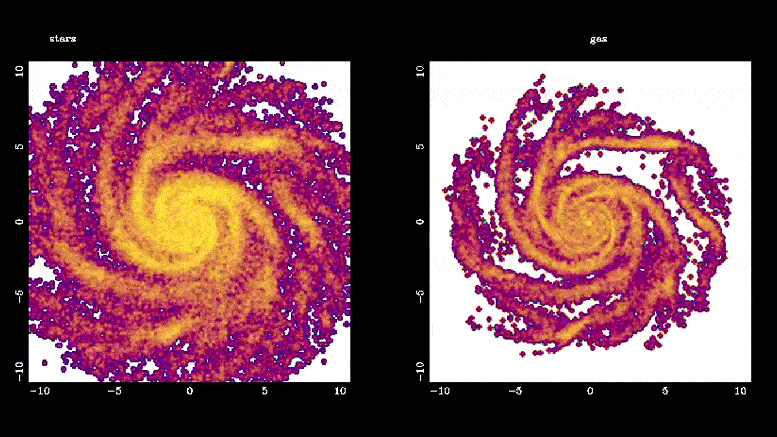
Αυτή η προσομοίωση δείχνει πώς σχηματίζονται οι αστρικές ράβδοι (αριστερά) και οι ροές αερίου που οδηγούνται από ράβδους (δεξιά). Οι αστρικές ράβδοι παίζουν σημαντικό ρόλο στη γαλαξιακή εξέλιξη διοχετεύοντας αέριο στις κεντρικές περιοχές του γαλαξία, όπου μετατρέπεται γρήγορα σε νέα αστέρια, 10 έως 100 φορές ταχύτερα από τον ρυθμό στον υπόλοιπο γαλαξία. Οι ράβδοι βοηθούν επίσης έμμεσα τον σχηματισμό υπερμεγέθων μαύρων οπών στα κέντρα των γαλαξιών κατευθύνοντας το αέριο τμήμα της διαδρομής. Πηγή: Françoise Combes, Αστεροσκοπείο του Παρισιού
νέες φωτογραφίες από[{” attribute=””>NASA’s James Webb Space Telescope (JWST) reveal for the first time galaxies with stellar bars — elongated features of stars stretching from the centers of galaxies into their outer disks — at a time when the universe was a mere 25% of its present age. The finding of so-called barred galaxies, similar to our Milky Way, this early in the universe will require astrophysicists to refine their theories of galaxy evolution.
Prior to JWST, images from the Hubble Space Telescope had never detected bars at such young epochs. In a Hubble image, one galaxy, EGS-23205, is little more than a disk-shaped smudge, but in the corresponding JWST image taken this past summer, it’s a beautiful spiral galaxy with a clear stellar bar.
“I took one look at these data, and I said, ‘We are dropping everything else!’” said Shardha Jogee, professor of astronomy at The University of Texas at Austin. “The bars hardly visible in Hubble data just popped out in the JWST image, showing the tremendous power of JWST to see the underlying structure in galaxies,” she said, describing data from the Cosmic Evolution Early Release Science Survey (CEERS), led by UT Austin professor, Steven Finkelstein.

The power of JWST to map galaxies at high resolution and at longer infrared wavelengths than Hubble allows it look through dust and unveil the underlying structure and mass of distant galaxies. This can be seen in these two images of the galaxy EGS23205, seen as it was about 11 billion years ago. In the HST image (left, taken in the near-infrared filter), the galaxy is little more than a disk-shaped smudge obscured by dust and impacted by the glare of young stars, but in the corresponding JWST mid-infrared image (taken this past summer), it’s a beautiful spiral galaxy with a clear stellar bar. Credit: NASA/CEERS/University of Texas at Austin
The team identified another barred galaxy, EGS-24268, also from about 11 billion years ago, which makes two barred galaxies existing farther back in time than any previously discovered.
In an article accepted for publication in The Astrophysical Journal Letters, they highlight these two galaxies and show examples of four other barred galaxies from more than 8 billion years ago.
“For this study, we are looking at a new regime where no one had used this kind of data or done this kind of quantitative analysis before,” said Yuchen “Kay” Guo, a graduate student who led the analysis, “so everything is new. It’s like going into a forest that nobody has ever gone into.”
Bars play an important role in galaxy evolution by funneling gas into the central regions, boosting star formation.
“Bars solve the supply chain problem in galaxies,” Jogee said. “Just like we need to bring raw material from the harbor to inland factories that make new products, a bar powerfully transports gas into the central region where the gas is rapidly converted into new stars at a rate typically 10 to 100 times faster than in the rest of the galaxy.”
Bars also help to grow supermassive black holes in the centers of galaxies by channeling the gas part of the way.
Αυτή η προσομοίωση δείχνει πώς σχηματίζονται οι αστρικές ράβδοι (αριστερά) και οι ροές αερίου που οδηγούνται από ράβδους (δεξιά). Οι αστρικές ράβδοι παίζουν σημαντικό ρόλο στη γαλαξιακή εξέλιξη διοχετεύοντας αέριο στις κεντρικές περιοχές του γαλαξία, όπου μετατρέπεται γρήγορα σε νέα αστέρια, 10 έως 100 φορές ταχύτερα από τον ρυθμό στον υπόλοιπο γαλαξία. Οι ράβδοι βοηθούν επίσης έμμεσα τον σχηματισμό υπερμεγέθων μαύρων οπών στα κέντρα των γαλαξιών κατευθύνοντας το αέριο τμήμα της διαδρομής. Πηγή: Françoise Combes, Αστεροσκοπείο του Παρισιού
Η ανακάλυψη ράβδων κατά τη διάρκεια αυτών των πρώιμων ηλικιών έχει ταράξει τα σενάρια της εξέλιξης των γαλαξιών με διάφορους τρόπους.
«Αυτή η πρώιμη ανίχνευση των ράβδων σημαίνει ότι τα μοντέλα της εξέλιξης των γαλαξιών έχουν τώρα μια νέα διαδρομή μέσα από τις ράβδους για να επιταχύνουν την παραγωγή νέων αστεριών σε μικρές ηλικίες», είπε ο Jogee.
Και η ύπαρξη αυτών των πρώιμων ράβδων αμφισβητεί τα θεωρητικά μοντέλα επειδή πρέπει να διορθώσουν τη γαλαξιακή φυσική προκειμένου να προβλέψουν τη σωστή αφθονία ράβδων. Η ομάδα θα δοκιμάσει διαφορετικά μοντέλα στα επερχόμενα έγγραφα.

Ένα μοντάζ εικόνων JWST δείχνει έξι παραδείγματα φραγμένων γαλαξιών, δύο εκ των οποίων αντιπροσωπεύουν τους υψηλότερους χρόνους ανάκτησης που έχουν ποσοτικοποιηθεί και χαρακτηριστεί μέχρι σήμερα. Οι ετικέτες στο επάνω αριστερό μέρος κάθε αριθμού δείχνουν τον ανάδρομο χρόνο κάθε γαλαξία, ο οποίος κυμαίνεται από 8,4 έως 11 δισεκατομμύρια χρόνια πριν (Gyr), όταν το σύμπαν ήταν μόλις 40% έως 20% της τρέχουσας ηλικίας του. Πίστωση: NASA/CEERS/Το Πανεπιστήμιο του Τέξας στο Ώστιν
Το JWST μπορεί να αποκαλύψει δομές σε μακρινούς γαλαξίες καλύτερα από το Hubble για δύο λόγους: Πρώτον, ο μεγαλύτερος καθρέφτης του του δίνει μεγαλύτερη ικανότητα συλλογής φωτός, επιτρέποντάς του να βλέπει μακρύτερα και με υψηλότερη ανάλυση. Δεύτερον, μπορεί να δει μέσα από τη σκόνη καλύτερα επειδή παρατηρεί σε μεγαλύτερα υπέρυθρα μήκη κύματος από το τηλεσκόπιο Hubble.
Οι προπτυχιακοί Eden Wise και Zilei Chen έπαιξαν σημαντικό ρόλο στην έρευνα εξετάζοντας οπτικά εκατοντάδες γαλαξίες, αναζητώντας αυτούς που φαινόταν να έχουν ράβδους, κάτι που βοήθησε να περιοριστεί η λίστα σε μερικές δεκάδες, ώστε άλλοι ερευνητές να μπορούν να την αναλύσουν με πιο εντατικούς υπολογισμούς . Προσεγγίζοντας.
Παραπομπή: «Πρώτη ματιά στο z > 1 Bars στο υπόλοιπο πλαίσιο του εγγύς υπέρυθρου με εικόνες JWST πρώιμης CEERS» Από Yuchen Guo, Sharda Joji, Stephen L Finkelstein, Zili Chen, Aiden Weiss, Michaela P Bagley, Guillermo Barrow, Stegen & Witts, Dale D. Kosevski, Jehan S. Καρταλτεπέ, Ελίζαμπεθ Τζ. McGrath, Henry C. Ferguson, Bahram Mobacher, Mauro Giavalescu, Ray A. Lucas, George A. Zavala, Jennifer M. Lutz, Norman A. Grojean, Mark Huertas-Company, Jesus Vega-Ferrero, Nimish P. Hathi, Pablo Arrabal Haro, Mark Dickinson, Anton M. Koekemoer, Casey Papovich, Nor Pirzkal, LY Aaron Yung, Bren E. Backhaus, Eric F. Bell, Antonello Calabrò, Nikko G. Cleary, Rosemary T. Cogan, MC Cooper, Luca Constantin, Darren Croton, Kelsey Davis Accepted, Alexandre de la Vega, Avishai Dekel, Maximilian Franco, Jonathan P. Gardner, Ben W. Holwerda, Taylor A. Hutchison, Viraj Pandya, Pablo G. Perez-Gonzalez, Swara Ravindranath, Caitlin Rose, Jonathan Trump, Weichen Wang, Αποδεκτό Επιστολές Αστροφυσικού Περιοδικού.
arXiv: 2210.08658
Άλλοι συν-συγγραφείς από το Πανεπιστήμιο του Όστιν είναι οι Stephen Finkelstein, Michaela Bagley και Maximilian Franco. Δεκάδες συν-συγγραφείς από άλλα ιδρύματα προέρχονται από τις Ηνωμένες Πολιτείες, το Ηνωμένο Βασίλειο, την Ιαπωνία, την Ισπανία, τη Γαλλία, την Ιταλία, την Αυστραλία και το Ισραήλ.
Η χρηματοδότηση αυτής της έρευνας παρασχέθηκε εν μέρει από το Roland K. Blumberg Endowment in Astronomy, το Ίδρυμα Heising-Simons και τη NASA. Αυτή η εργασία βασίστηκε σε πόρους στο Κέντρο Προηγμένων Υπολογιστών του Τέξας, συμπεριλαμβανομένου του Frontera, του πιο ισχυρού υπερυπολογιστή σε αμερικανικό πανεπιστήμιο.

“Ερασιτέχνης διοργανωτής. Εξαιρετικά ταπεινός web maven. Ειδικός κοινωνικών μέσων Wannabe. Δημιουργός. Thinker.”


